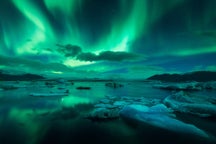Mýrdalsjökull to lodowiec znajdujący się na południu islandzkich wyżyn. Jest to czwarta co do wielkości pokrywa lodowa w kraju, zajmująca prawie 600 kilometrów kwadratowych, a jej najwyższy szczyt ma prawie 1500 metrów wysokości. Najbardziej znany jest z tego, że znajduje się na szczycie słynnego i potężnego wulkanu Katla.
Wycieczki jednodniowe, zwłaszcza zwiedzanie południowego wybrzeża, pozwalają dotrzeć do tego lodowca, a także można go zobaczyć w ramach wielu letnich pakietów wakacyjnych, takich jak te 6-dniowe wakacje. Ci, którzy wynajmują samochód, mogą samodzielnie do niego dojechać.
Mýrdalsjökull jest widoczny z drogi nr 1 na południowym wybrzeżu, znajdując się na północ od wioski Vík. Jest on odwiedzany podczas niektórych wypraw na skuterach śnieżnych, wypraw do jaskiń lodowcowych i wycieczek helikopterem, a jeden z jego wylotów lodowcowych, Sólheimajökull, jest najpopularniejszym miejscem w kraju do wspinaczki lodowej i wędrówek po lodowcu.
Erupcje pod Myrdalsjokull
Od 2010 roku świat wie o wulkanie pod Eyjafjallajökull — w końcu wstrzymał on europejskie podróże lotnicze na ponad tydzień i wprawił w osłupienie czytelników wiadomości na całym świecie. Niewielu jednak zdaje sobie sprawę ze znacznie większego wulkanu znajdującego się tuż obok.
Mýrdalsjökull skrywa Katlę, jeden z najbardziej aktywnych wulkanów w kraju, który od 930 roku wybucha średnio raz na pięćdziesiąt lat. Ze względu na znajdujący się nad nim lodowiec, erupcje te powodują powstawanie ogromnych chmur popiołu. To właśnie to zjawisko prowadzi do uziemienia lotów, zanieczyszczenia upraw i zatrucia zwierząt hodowlanych, a także może potencjalnie zmienić klimat na świecie.
 Autor zdjęcia: Ruslan Valeev
Autor zdjęcia: Ruslan Valeev
Ostatnia duża erupcja Katli miała miejsce w 1918 roku, kiedy to doszło do tak ogromnych powodzi, że południowa linia brzegowa wydłużyła się o pięć kilometrów. Obszar ten jest również bardzo podatny na powodzie lodowcowe lub „jökulhlaup” podczas erupcji, nawet jeśli lawa nie przebija się przez powierzchnię lodu. Powodzie te są równie niebezpieczne, jak sama lawa, ponieważ już wcześniej zniszczyły całe islandzkie wioski.
Z tego powodu historycznie obszar ten był mało zasiedlony.
Katla jest połączona z tym samym systemem wulkanicznym co Eyjafjallajökull i zwykle wybucha gwałtownie kilka lat po erupcji Eyjafjallajökull. Jak powiedział były prezydent Islandii Ólafur Ragnar Grímsson w 2010 roku:
„Czas erupcji Katli zbliża się wielkimi krokami... nadszedł najwyższy czas, aby europejskie rządy i władze linii lotniczych w całej Europie i na świecie zaczęły planować ewentualną erupcję Katli”.
Tak więc erupcja Katli jest obecnie opóźniona o kilka lat. Wulkan jest ściśle monitorowany, a drogi wokół niego są zamykane, gdy wzrasta aktywność sejsmiczna. Wszystkie zamknięcia dróg wokół Islandii można znaleźć na stronie internetowej Zarządu Dróg i Wybrzeża.
Wycieczki po Myrdalsjokull
Ponieważ erupcje nie są spodziewane w najbliższym czasie, wycieczki nadal odbywają się na Mýrdalsjökull, umożliwiając odwiedzającym podziwianie lodowca. Możliwe jest na przykład poruszanie się skuterami śnieżnymi po jego powierzchni i zwiedzanie jaskiń lodowcowych pod nim przez cały rok, z wyjazdami zarówno z Reykjaviku, jak i miejscowości Vík.
Biorąc pod uwagę, że jaskinie lodowcowe pod lodowcem Vatnajökull są zwykle dostępne tylko od listopada do marca, zapewnia to szersze możliwości dla osób podróżujących do Islandii poza okresem zimowym. Należy jednak pamiętać, że jaskinie w Mýrdalsjökull nie mają takiego samego błękitnego lodu.
Wycieczki nieopodal Myrdalsjokull
Mýrdalsjökull można zobaczyć podczas wszystkich wycieczek po południowym wybrzeżu, które docierają do Viku i dalej, o ile panuje dobra pogoda. Można go również podziwiać z góry w trakcie lotów helikopterem z Reykjaviku.
Najlepsze widoki na lodowiec są jednak podczas wędrówki popularnym szlakiem turystycznym Fimmvörðuháls, który biegnie między Eyjafjallajökull i Mýrdalsjökull. Część tej wędrówki można odbyć w ciągu jednego dnia lub można przejść całą trasę z Þórsmörk do Skógar podczas trzydniowej wyprawy.










